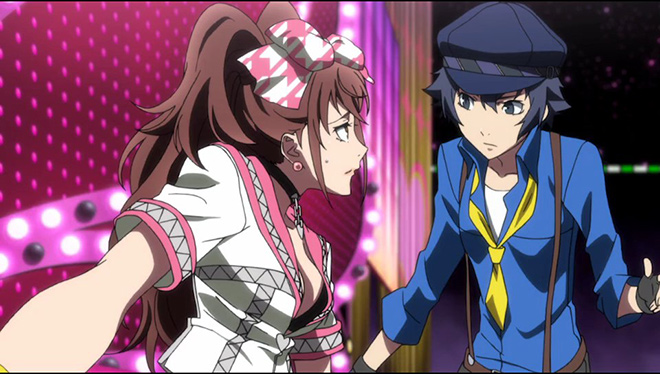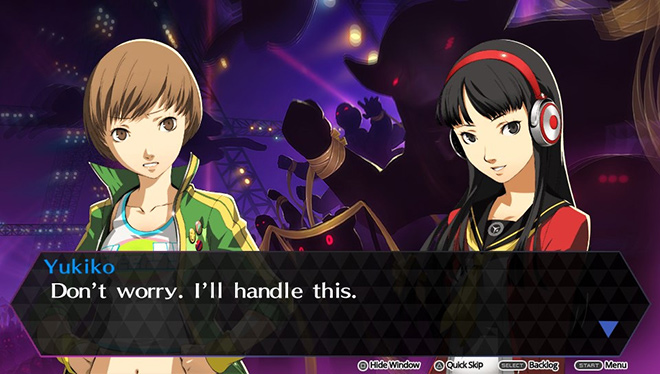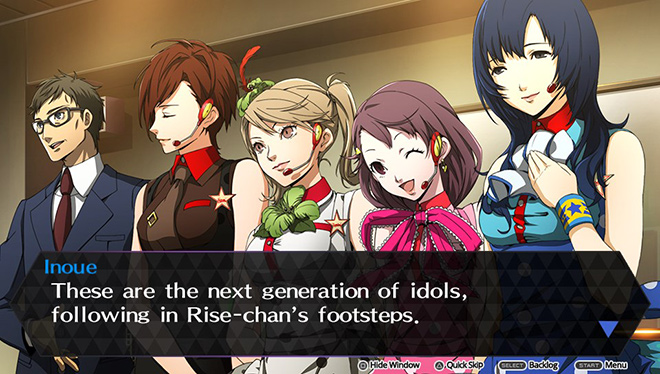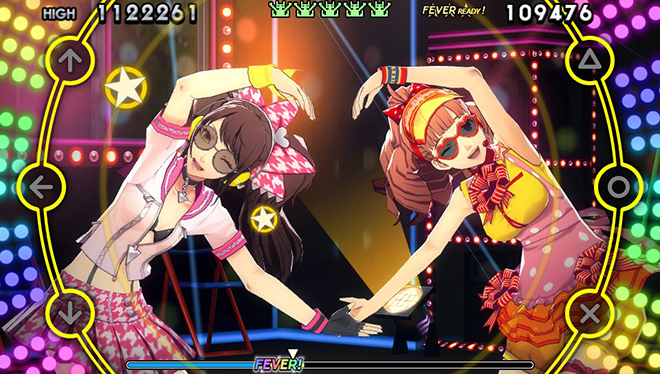Summer Flame Day: Don’t Dance All Night

Persona 5: Dancing in Starlight and Persona 3: Dancing in Moonlight are both slated to hit the West in early 2019. First impressions of the gameplay suggest the story won’t be quite as serious as Persona 4: Dancing All Night. With news coming out about the upcoming rhythm games, turning my sights on the Persona 4 spinoff that started it all is only fitting for Summer Flame Day. I’ve felt nothing but animosity toward the game since I got it in 2015 and only decided to finish it for today. Amusingly, things took a cruel turn when my save data was wiped from my PSTV. You guessed it, I had to replay the game from scratch. Upon finishing the game three years after its release, my opinion hasn’t changed. Dancing All Night is unnecessary canon at best and a blatant cash grab at worst. This game doesn’t need to exist.
Persona 4: Dancing All Night released on June 25, 2015, a little over a year after the release of Persona Q: Shadow of the Labyrinth. The close release wasn’t a surprise as Atlus had announced that these spin-offs along with Persona 5 were coming down the pipe. While Persona Q was a cash grab in its own way, the fusion of modern Persona and Etrian Odyssey was logical from a gameplay and mechanics perspective—both were JRPGs. The previous cross-over, Persona 4 Arena Ultimax was also logical because it isn’t uncommon to feature JRPG characters in fighting games. Dancing All Night is an outlier, perhaps an odd result of the 2013 Sega purchase of Atlus. The game was originally a collaboration between Atlus and Dingo (the same developers of the Hatsune Miku Project DIVA series) with the latter serving as lead developer. Later the development shifted to the Persona Team for quality reasons. The result was a fusion of the Project DIVA games, a visual novel style story mode similar to the Arena games, and a variety or remixes from P4 sans the Arena games and the anime.

From start to finish, the only thing remotely unique about Dancing All Night was the story (more on that later). I mainly stuck to the story mode, so I won’t be touching upon free dance modes, though I did dabble in them when I first received the game. The rhythm gameplay itself is uninspired. To be honest, I’m not a fan of rhythm games yet I’ve played enough to know that DAN’s offering is lacking. Button presses and the choreographed dances in the background do not sync up to the track being played, creating a slight disconnect. Unlike the Project DIVA games, the backgrounds don’t have the benefit of being a music video. This disconnect help make the game feel like more of a chore to play than it should have been.
I originally praised the soundtrack for being the high point of the game, as the remixes are excellent. Later, I was bitterly disappointed when I discovered a good chunk of the songs were taken straight from the Never More –Reincarnation: Persona 4- album. Yes, the DAN soundtrack has a few original tunes, but the catchiest remixes are largely unaltered from Never More. To be certain, I listened to both soundtracks and the songs are indistinguishable. The disappointment comes from the fact that Atlus couldn’t even be bothered to create a cache of new remixes for this rhythm game. Instead they went for existing assets in a game filled with them.
Speaking of reused assets, they are one of the reasons why I loathed story mode. (Besides you know, being forced to play a dancing game to complete P4’s overall canon.) The visual novel parts of Arena worked well because it was an interesting way to tell a long story. It’s not surprising that Atlus would go with a similar format. The assets themselves were mostly ripped straight from Arena, with a few modifications such as clothing and new text boxes. Despite this game taking place after Persona 4 Golden, where everyone had different appearances in the epilogue, they went straight back to the same high school look. At this point in the story neither Yu nor Naoto even attend Yasogami High. An in-game explanation of needing the characters to appear the same as they did in P4 was given, but it is pretty shallow. I’m going to cynically say that it was easier for Atlus to reuse the Arena assets with slight modifications. This is despite them having a secret chapter that features their post P4G designs.

Still frames also get the lazy treatment in DAN. The still artwork is extremely limited and backgrounds are reused to an annoying degree. I’ve lost count how many times I’ve seen the still of shadows wrapped with yellow ribbons that represents the Midnight Stage’s audience. One important aspect of a good visual novel is variety of stills and backgrounds, which DAN lacks. Fortunately, there were anime cut scenes sprinkled into story mode.
The plot was another element of story mode lacking in variety. Its brevity was both a benefit and a detriment. It was beneficial to the story because a rhythm game shouldn’t a 60-100 hour affair, but detrimental because the new characters didn’t receive much development. The Investigation Team has been summoned on summer break by Rise to have them participate in the “Love Meets Bonds Festival” as her backup dancers. She’s finally ready to return as the idol “Rissete.” Also making an appearance is Rise’s rival, Kanami Mashita, leader of the idol group Kanamin Kitchen. The two groups are slated to have a dance-off at the festival.
Things go awry when rumors of a dead idol being seeing on the festival’s website at midnight go around. Naturally the Investigation Team checks it out and they’re drawn into a world not unlike the shadow world. The next day the Kanamin Kitchen girls are also pulled into the world when a portal opens and yellow ribbons shoot out to grab them. Kanami is spared when her manager pushes her to safety and is instead dragged in. The Investigation Team is left to explore the shadow world, and save the idols and their manager from the malevolent entity controlling shadows. They can’t fight with their personas, but must dance to express their feelings. Meanwhile Kanami is left alone in the real world. She is kept company by Nanako, and Dojima investigates the missing kids and their manager.

The in-game reason for dancing was because the malicious entity that kidnapped Kanamin Kitchen desired bonds with others. To create those bonds the entity subverted the original message of the shadow world to ultimately be true to oneself by insisting that its victims be what others see them as. Truth and self-realization be damned. Also, in this shadow world violence is prohibited, so in order for the power of friendship to resonate and reach people, dancing is required. Did that make you roll your eyes? Imagine having to rinse and repeat this formula without much depth or character exploration for eight LONG hours.
To be fair, the story grew on me. I hated the first half because I didn’t care much for the girls in Kanamin Kitchen. Their issues weren’t explored as deeply as the P4 cast in previous games and I found their animal themes to be dumb (a cow, lamb, hen, piglet, and stag? Really Atlus?). Nevertheless, P4’s original “be true to yourself” theme was there. The reveal of the entity, the idol who committed suicide years before the game’s story, and how she was connected to Kanami did have a satisfying conclusion. I’m not going to spoil it, but it wouldn’t be a Persona game without a demi-god causing trouble. Even with an overall decent story, this addition to the canon is a pointless vehicle built to justify a dancing game.

So does the game do anything right? The majority of DAN’s budget went into motion capture for the dancers who served as character models for the choreographed sections. The animation itself is beautiful, but as I said earlier it doesn’t match up with button inputs. If you’re a stickler for matching rhythm, this game will bother you. If you don’t care and just want to play your favorite characters while listening to great music, by all means knock yourself out.
I’ll say it again, Persona 4: Dancing All Night is a game that doesn’t need to exist. Even if parts of it turned out decently, it remains a cash grab from Atlus and Sega. Thankfully, this game was the last stop in a series of never-ending spinoffs (that are somehow canon), as fans waited for Persona 5. Will I be sticking around to play the next iteration of cash grabs- er, rhythm games? Hopefully not.






I’m glad you finally managed to finish this, though mainly for everyone else’s amusement! After all this time, I had no idea that many of the tracks were from the Nevermore soundtrack, so I’ll have to search that out.
I hope you enjoyed the review! LOL. Imagine my surprise when hearing the Never More soundtrack. I was *not* happy.